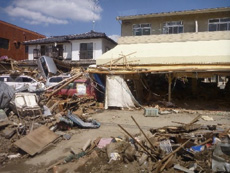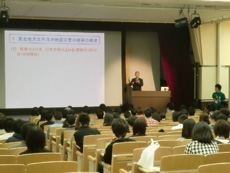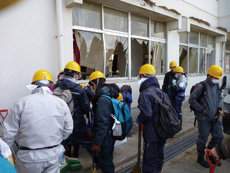 Go
Go
Onsite Report
Reacting to the Great East Japan Earthquake ~What can we do to help now and in the future?~
Rika Yamaguchi
Waseda Rescue
3rd year student, School of Creative Science and Engineering

Photograph taken in Ishinomaki City

Lecture at Okuma Auditorium

Volunteers shoveling mud in Ishinomaki City
I would like to offer my deepest sympathies and condolences to all victims of the Great East Japan Earthquake. I pray for a speedy recovery and reconstruction.
On March 11th, a devastating magnitude 9.0 earthquake occurred and brought terrific damage to the Tohoku and Kanto regions. Even now, the aftermath of the quake continues to affect daily life.
Until now, Waseda Rescue conducted activities for raising awareness towards disaster prevention. These activities were held at Waseda University and surrounding areas with the goal of reducing damage before the actual occurrence of an earthquake. Now, in order to provide aid after the recent earthquake, Waseda Rescue is conducting activities which utilize links between people that were formed during such disaster prevention activities. Our activities feature partnerships within our university, as well as with other universities and experts. Specifically, on April 6th and 18th, Chairperson Norio Udagawa of the International Aid Research Center was invited to Okuma Auditorium in order to give students a lecture on disaster volunteer activities. His lecture was aimed at students who wanted to participate in onsite volunteer activities but do not know how to proceed. Waseda Rescue provides opportunities for students to learn important knowledge related to volunteering, such as cautions when working onsite and the importance of being emotionally prepared. By spreading such knowledge, we construct a system in which students can perform volunteer activities safely and without causing trouble at disaster areas. In the future, we will use media such as the Waseda Rescue blog in order to continue to promptly communicate information on training and onsite volunteering.
Furthermore, the Waseda University Hirayama Ikuo Volunteer Center (WAVOC) conducted recruitment for a total of 3 volunteer missions for earthquake recovery conducted during April in Ishinomaki City. Of course, onsite work is not the only form of volunteering. There are many things which can be done in the course of our daily lives, such as making donations. However, the recent earthquake requires long-term aid in a variety of ways. Therefore, it is important not to dismiss the disaster as someone else's problem. Instead, it is vital to get a first-hand experience of conditions and to always remain conscious of the disaster areas. Also, we must not forget that there is a 70% chance that an earthquake centered in the Tokyo metropolitan area will occur in the next 30 years. Advance preparation is the only way to reduce the damage caused by earthquakes. It is important to once again consider what actions we are capable of taking, particularly advance preparations.
(May 12th, 2011)
